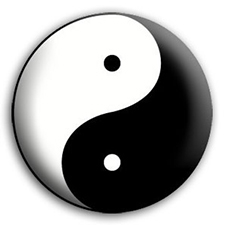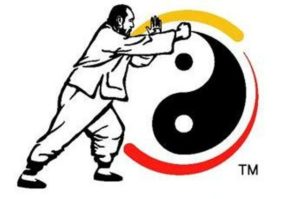Slanted FlyingJournal of Tai Chi Chuan
Training
Attention Vs. Attenuation in Taijiquan
In martial arts we want to clearly have the details WITHOUT losing sight of the whole picture. But this is contrary to the way that we normally process information, focusing on one thing (or at most two things) while attenuating or ignoring others. We can’t see the forest for the trees (focusing on the detail of a single tree and losing sight of the forest in general). We want to be able to focus on specifics without losing awareness of other aspects of our environment (the generalities).
What was important for survival was to become aware of possible threats coming at us, and that is primarily processed when seeing motion in our peripheral vision. The relative speed of our brain’s processing of this information (the dorsal stream from the visual cortex; primarily processing the “where” information or the location in space) is faster than the processing of the detailed examination of things in our foveal vision (using the ventral stream from the visual cortex and primarily processing the “what” information; when we are focused on something that we are manipulating with our hands, for example).
But when our attention is consumed by small details when using foveal vision (center of the visual field), we often miss the peripheral signals because our brain attenuates them to the background. Magicians use our singular attention and attraction to movement to distract us from what they are doing. It is also why we are often distracted by the color and movement of saber/dao (刀) cloths/colors or sword/jian (劍) tassels. When our monkey mind is captured by one thing, there are many other things that are missed.
We want our perception to be like when juggling where the balls are kept track of through peripheral vision, yet we retain the precision necessary to catch the balls with our hands. Focusing on one ball (having one ball “capture” our attention) would attenuate our awareness of the other balls and would cause us to drop them. We want awareness of, but not fixation on, our opponent, and this is sometimes achieved by a soft focus on the opponent’s chest while keeping their arms and legs within our peripheral visual awareness.
Ideally we want to know the opponent through touch but, like with vision, the touch should also not capture our attention and therefore reduce our awareness of other things that are happening. Reaction times based on touch are typically faster than those from vision. Although many factors can contribute to reaction times, in general touch is ~2/3 to ~3/4 the reaction times based on vision. Reflex actions can even be almost instantaneous since they bypass brain processing and do not require the higher order cognitive processing that vision requires.
The stretch reflex is used to maintain joint angles and, since it is a reflex action, it is almost instantaneous. If a practitioner is maintaining peng (掤 structural fullness), then the stretch reflex could respond to anything that disturbs that structure. On the other hand, vision has a ~200msec delay. This visual delay is why we infer continuous motion when viewing film or TV, which use frame rates of ~24 frames/sec or higher (we would see flickering between images when shown at frame rates slower than our visual processing speed).
Although studies have shown that reaction times for stimuli that are being directly looked at (foveal vision) are faster than those in our peripheral vision, these studies are primarily done with stationary simple stimuli rather than cases where multiple important stimuli are presented simultaneously (like from different directions, or using different stimuli types, e.g., some visual and some through touch). With the tendency of our monkey mind to be distracted by one thing and miss others, these studies do not represent combat situations very well since combat needs awareness of multiple complex stimuli simultaneously, and movement is an important factor.
Reaction time also depends on one’s state of attention (or “arousal”), with the fastest times being when in an intermediate state, being neither too relaxed nor too tense. As an additional note for those using Taijiquan martially, it has been shown that one’s breathing cycle can influence reaction times, with reactions being faster during expiration than during inspiration. It would therefore be of some benefit to attack an opponent when they are breathing in, and to breathe out when attacking or defending.
In Taijiquan we need to avoid tuning out information, like from proprioception and peripheral vision, so that we remain aware; but without having our minds captured by single distractions. Yet we simultaneously need to retain our precision and therefore the awareness of our actions and movements. Only then can we hope to understand what the situation requires in response to the perceived incoming information. Awareness (知覺 zhijue) is the perception (覺) of what something is plus the realization (知) of what it is. Or, as stated in Taijiquan, we need ting (听 listening) and dong (懂 understanding).
We need to train our bodies to feel correct as a whole. When initially learning, we need to focus on specific individual elements, but eventually we want to have those individual elements coordinate into one whole. Then we will have only the one whole to pay attention to rather than the numerous individual elements. When we have achieved the ability to coordinate ourselves into one whole, then we can free up our minds to also pay attention to other things, like an opponent (while not losing the correct feel of ourselves).
After training the mind in this way, one may then be able to achieve what is mentioned in the classic “THE TAIJI BOXING TREATISE OF WANG ZONGYUE OF SHANXI” (山右王宗岳太極拳論) (Brennan translation): “Once you have ingrained these techniques, you will gradually come to identify energies, and then from there you will work your way toward something miraculous. But unless you practice a lot over a long time, you w











